Popular culture
- Popular Culture Regions
- Diffusion in Popular Culture
- The Ecology of Popular Culture
- Cultural Integration in Popular Culture
- Landscapes of Popular Culture
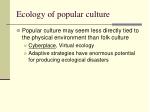
Ecology of popular culture
- Popular culture may seem less directly tied to the physical environment than folk culture
- Cyberplace, Virtual ecology
- Adaptive strategies have enormous potential for producing ecological disasters

Environmental influence
- The physical environment still can exert an influence on members of popular culture even with their loss of close ties to nature
- Some natural hazards are actually intensified
- Millions of city dwellers live astride the major earthquake zone in California
- Popularity of seaside residences greatly increases dwelling susceptible to hurricane destruction along the Gulf Coast
- Epidemic diseases can spread more rapidly along modern transportation networks
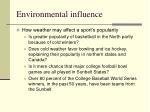
Environmental influence
- How weather may affect a sport’s popularity
- Is greater popularity of basketball in the North partly because of cold winters?
- Does cold weather favor bowling and ice hockey, explaining their popularity in northern states and Canada?
- Is it mere chance that major college football bowl games are all played in Sunbelt States?
- Over 80 percent of the College Baseball World Series winners, in the past 50 years, have been teams from the Sunbelt

Environmental influence
- Why climatic influence on different sports is waning
- Huge covered stadiums make it possible to play football and baseball indoors
- Artificial wave-making machines permit surfboarding in Arizona’s desert
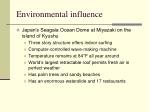
Environmental influence
- Japan’s Seagaia Ocean Dome at Miyazaki on the island of Kyushu
- Three story structure offers indoor surfing
- Computer-controlled wave-making machine
- Temperature remains at 84°F all year around
- World’s largest retractable roof permits fresh air in perfect weather
- Has palm trees and sandy beaches
- Has an enormous waterslide and 17 restaurants
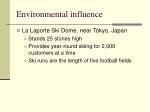
Environmental influence
- La Laporte Ski Dome, near Tokyo, Japan
- Stands 25 stories high
- Provides year-round skiing for 2,000 customers at a time
- Ski runs are the length of five football fields
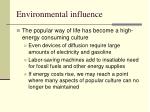
Environmental influence
- The popular way of life has become a high-energy consuming culture
- Even devices of diffusion require large amounts of electricity and gasoline
- Labor-saving machines add to insatiable need for fossil fuels and other energy supplies
- If energy costs rise, we may reach a point where many aspects of popular culture can no longer be maintained
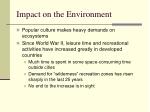
Impact on the Environment
- Popular culture makes heavy demands on ecosystems
- Since World War II, leisure time and recreational activities have increased greatly in developed countries
- Much time is spent in some space-consuming time outside cities
- Demand for “wilderness” recreation zones has risen sharply in the last 25 years
- No end to the increase is in sight

Impact on the Environment
- Massive presence of people in recreational areas results in damage to physical environment
- National parks suffer from traffic jams, residential congestion, litter, and noise pollution
- Off-road vehicles have caused soil loss and long-term soil deterioration
- As few as several hundred hikers can beat down trails
- Vegetation is altered
- Erosion is encouraged
- Wildlife diminished
- The more humans cluster in cities and suburbs, the greater their impact on open areas
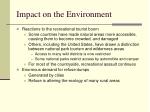
Impact on the Environment
- Reactions to the recreational tourist boom
- Some countries have made natural areas more accessible, causing them to become crowded, and damaged
- Others, including the United States, have drawn a distinction between national park tourism and wilderness areas
- Access to many wild districts is now restricted
- Some national parks restrict access by automobile and camper
- For most of the countryside, recreational assault continues
- Enormous demand for refuse dumps
- Generated by cities
- Refuse is altering the ecology of many rural areas

Landscapes of consumption
- Eye catching commercial “strips” along urban arterial streets
- Study of the evolution of such a strip in an Illinois college town
- Covered the period 1919 to 1979
- Street changed from single-family residential to a commercial focus
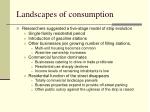
Landscapes of consumption
- Researchers suggested a five-stage model of strip evolution
- Single-family residential period
- Introduction of gasoline stations
- Other businesses join growing number of filling stations,
- Multi-unit housing becomes common
- Absentee ownership increases
- Commercial function dominates
- Businesses catering to drive-in trade proliferate
- Residential use sharply declines
- Income levels of remaining inhabitants is low
- Residential function of the street disappears
- Totally commercial landscape prevails
- Business properties expand to provide off-street parking
- Often public outcry against the ugliness of the strip is raised
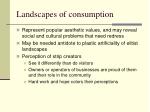
Landscapes of consumption
- Represent popular aesthetic values, and may reveal social and cultural problems that need redress
- May be needed antidote to plastic artificiality of elitist landscapes
- Perception of strip creators
- See it differently than do visitors
- Owners or operators of businesses are proud of them and their role in the community
- Hard work and hope colors their perceptions
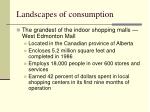
Landscapes of consumption
- The grandest of the indoor shopping malls — West Edmonton Mall
- Located in the Canadian province of Alberta
- Encloses 5.2 million square feet and completed in 1986
- Employs 18,000 people in over 600 stores and services
- Earned 42 percent of dollars spent in local shopping centers in its first nine months of operation
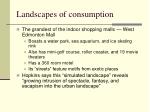
Landscapes of consumption
- The grandest of the indoor shopping malls — West Edmonton Mall
- Boasts a water park, sea aquarium, and ice skating rink
- Also has mini-golf course, roller coaster, and 19 movie theaters
- Has a 360 room motel
- Its “streets” feature motifs from exotic places
- Hopkins says this “simulated landscape” reveals “growing intrusion of spectacle, fantasy, and escapism into the urban landscape”

Leisure landscapes
- West Edmonton Mall is more than a landscape of consumption being clearly designed as much for leisure as for shopping
- Leisure landscapes take many forms
- “RV resort landscape” of greater Phoenix where “recreational nomads” spend winter months
- In the United States alone golf courses occupy an area twice the size of the state of Delaware

No comments:
Post a Comment